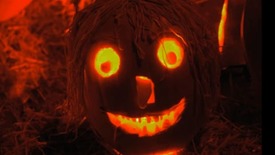 With Halloween approaching, the nights getting darker, what more atmospheric place could there be to get a spooky chill than the Forest of Dean? A slight quickening of your step walking down the lane - a slight start at the cough of sheep or the high pitched scream of a fox? There's some great Forest ghost stories too, Harry Beddington's poem The Mon in White for one. And with spooky connections to real historical events there's the haunted houses described by Sue Law in her Ghosts of the Forest of Dean (1982). But many of the best ghost stories turn out to be not quite what they first seem - though scary all the same! The ghost in The Landlord's Story, in Charles Grindrod's Tales In the Speech House, turns out to be....well that would be spoiling it! So, in William S Wickenden's A Rum Story from his A Queer Book (1850), is it really the Devil himself that popped up in Awre church? Here's a clue and a question - is this the earliest English literary mention of a Jack O'Lantern?? Enjoy... PASSAGE V.
0 Comments
Leave a Reply. |
Archives
June 2024
|
 RSS Feed
RSS Feed


